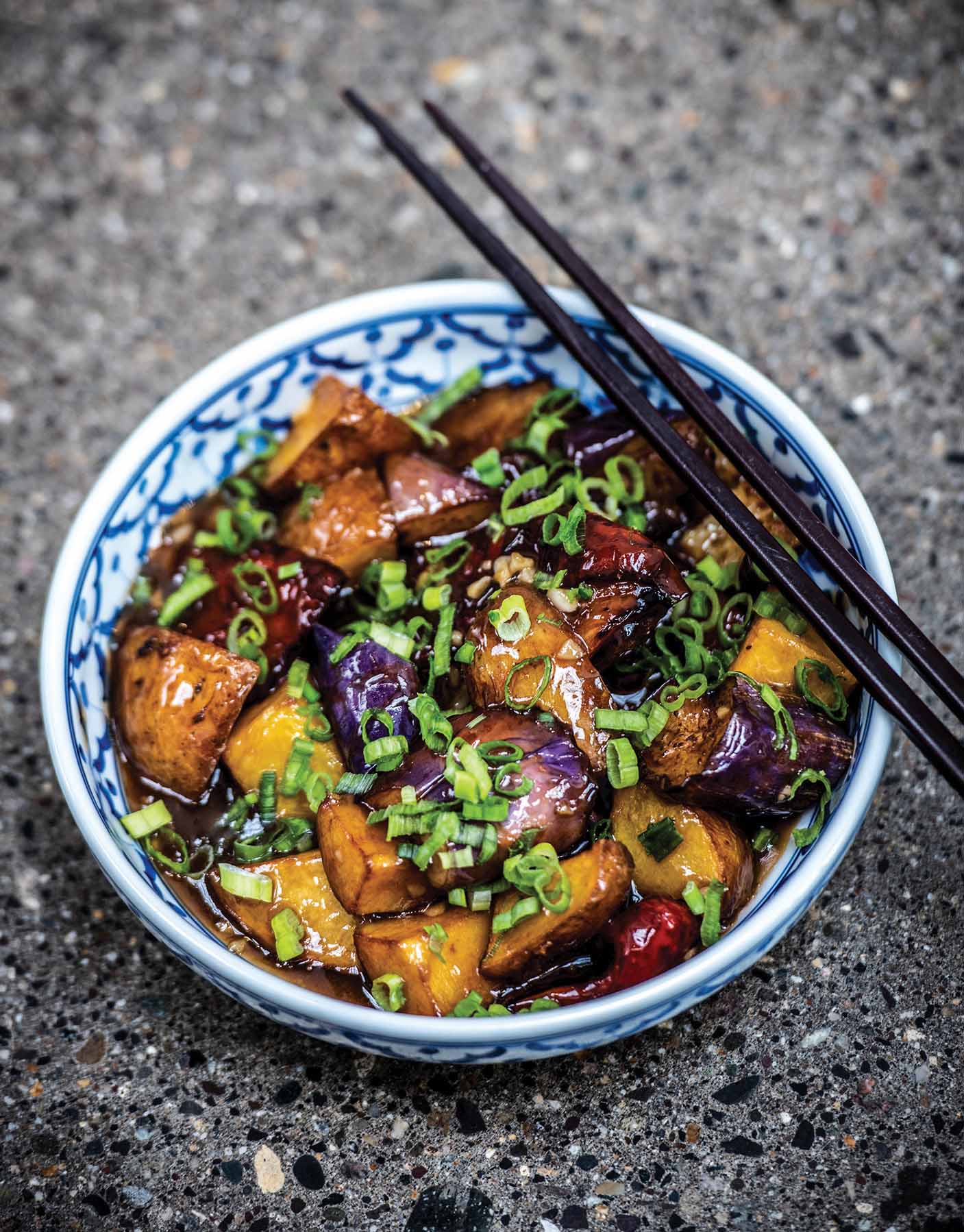
01 Aug Dining Out: Reinvention
It’s Friday afternoon, the hottest day of the year so far, and there’s already a line outside the door at Shan in Bozeman, Montana’s northside Cannery District. We figure it will be a while. And we don’t mind. It’s not every day you get to eat at what the James Beard Foundation recognizes as one of the best new restaurants in the U.S.
But we are wrong: A friendly host greets us and asks how many there will be.
“Just three,” I say. “We don’t mind waiting for a seat at the bar.”
“Nah, we can get you in right now,” he says. “Come on.”

Owners Jarrett Wrisley and Candice Lin pose with their son, August, in the doorway separating the old Shan from the newly renovated addition. The pleasure of having access to nature and a more sustainable lifestyle are among the reasons Wrisley is so glad to have moved his family to Bozeman.
We snake through the dining room, past the open kitchen where a young crew is talking and laughing. My daughter lifts her nose to the ceiling, taking in the deep, smoky aroma of meat and the piquant scent of curry. (She is a tried-and-true carnivore, a seeker of new flavors, and this is her jam.) There are servers bustling about, all in T-shirts, some in aprons. But no one is in a rush. No one seems stressed. We step through a wooden keyhole archway into another dining room with a handsome bar. The tables — simple, wood, modern — are filling up.
In June, Shan reopened following a remodel that doubled the restaurant’s capacity, and owners Jarrett Wrisley and Candice Lin attended the James Beard Awards in Chicago as one of 10 finalists in the Outstanding New Restaurant category. It’s not even 5 o’clock and the place is hopping.
Shan is the brainchild of Wrisley and Lin, and the result of good luck following bad. After studying East Asian history at Colgate University and taking advantage of a study-abroad year in Beijing, Wrisley stayed in Asia, working as a writer and foreign correspondent for such publications as The Atlantic, Travel & Leisure, and Food & Wine, covering everything from food and culture to politics and the economy. When the recession hit in 2008, writers were the last to get paid and freelancing became an onerous way to make a living. “So I did the only other thing I could do,” says Wrisley. “I started cooking.”
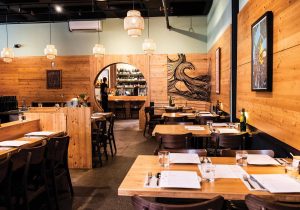
“I don’t think restaurant owners are ever really sure that anything will work,” says Wrisley. But Shan was such a hit that, after its opening in April 2023, Wrisley doubled its space with an addition in late spring of 2024.
During two decades of living in China, Hong Kong, and Thailand, the husband-and-wife team opened seven celebrated restaurants in Bangkok and Hong Kong, including Soul Food Mahanakorn, which served traditional Thai with American barbecue, and Appia, a stunning rustic Roman trattoria. The couple traveled the world over for food inspiration — including an Italian farm they owned outside of Rome for a while — and made what they loved.
Then, the pandemic hit. For two and a half years, Wrisley shuttered their establishments while still keeping more than 150 people on the payroll. It took everything.
“You couldn’t give them away,” Wrisley says of their once-booming restaurants mid-pandemic. “Well, eventually I did.” He transferred ownership to their business partner and friends. He smiles the smile of someone who has been in the ring, taken his punches, and is yet unafraid to go back in.
Wrisley and Lin came back to the U.S. in 2021 with their then 4-year-old son and, after visiting family on the East Coast, made their way out West in an old Subaru. The family spent four months on the road, crisscrossing Colorado, Utah, Wyoming, Idaho, and, eventually, Montana.
“We needed to stop,” Wrisley says. “Winter was coming, and we couldn’t camp anymore.”
A stop for gas in Bozeman changed everything.
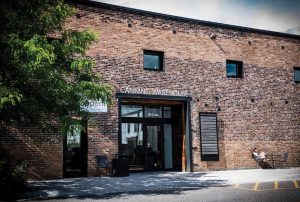
Bozeman’s Cannery District on the north side of town has undergone a tremendous revitalization of late. The area, including the Cannery Warehouse in which Shan is located, was packaging peas and carrots from the valley in the early 1900s at a time when Gallatin County produced 75 percent of the nation’s peas.
We are seated near the bar at one of Shan’s long community tables. It has the feeling of a farm table, and we wonder who might join us. When the bartender offers us menus, one for drinks and the other for food, my daughter is delighted to see her favorite Mexican Coke, and my partner and I take time with the extensive wine list and assortment of beer, cider, and sake. With so many small producers and unfamiliar choices, what’s clear from the impressive variety is that someone knows what they’re doing and is having a lot of fun doing it.
The à la carte menu is concise: one side of one page. There are “snacks” ranging from Thai beef jerky and Lazi-Ji chicken wings to smoked tofu and lamb dumplings. (It’s worth noting that Shan’s website acknowledges that the dumplings cannot be reserved, unlike a table; when they’re gone, they’re gone. And they’re usually gone early.)
There are curries, stews, soup dishes, and another section for barbecue — including lamb skewers and sticky tamarind ribs — plus a daily selection of local meats from the grill. There are four different noodle dishes incorporating beef, chicken, pork, or lamb; two vegetarian wok dishes; and two desserts. That’s it. Simple, right?
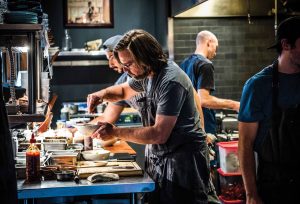
In addition to everything else he does to keep Shan in motion, Wrisley spends plenty of time in the kitchen because he loves it. Three chefs show up at 8 a.m. each morning to start preparing the day’s dishes.
For the diner, yes. It’s not hard to decide because nothing you eat here will taste like anything you’ve tasted before. And you can’t go wrong. For the staff, however, this kind of simplicity takes dedication. Three chefs show up every morning at 8 a.m. and cook all day. The alchemy of ingredients and flavors is bold and complex, and everything is presented like a work of art. The Chicken Khao Soi, for example, is a flavorful coconut chicken curry over egg noodles with mustard pickles, lime, and crispy noodles for rising-out-of-the-bowl beauty and crunch. The only reason my daughter didn’t finish her bowl was that she wanted to taste it again the next day. (It was perfect both times, she says.) My partner and I ordered two of several specials, a flank steak and pork medallions, perfectly cooked and with sauces that defy description. They are gingery and fresh with the perfect amount of tang and heat. This meal, served family style, is the first time I’ve ever wanted to use the word “intrepid” to describe flavors. But delectable works, too.
Bozeman felt right to Wrisley and Lin from the get-go, but they didn’t know a soul and had to start from scratch. Success as restaurateurs had come quickly in Asia, then disappeared entirely with Covid. Still, even after losing everything, when it came time to reinvent himself in Montana, Wrisley missed the kitchen.
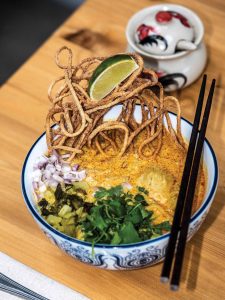
Shan’s Chicken Khao Soi is an artful crowd pleaser, with chicken in a coconut curry with crispy noodles, mustard pickles, and lime over more noodles.
“I had sworn off restaurants,” he says. But he worked as a private chef and even started an underground supper club out of their house until he got shut down by the food police. He wasn’t giving up. “I was missing what I was really supposed to be doing,” he says. The longing was physical, he describes, almost like missing a limb. “I needed a restaurant again. I didn’t want it, but I needed it.”
Wrisley admired various restaurants around Bozeman, including Blackbird and Little Star Diner. “Those are the sort of restaurants I like to eat in: locally sourced ingredients cooked in a thoughtful way.” But Wrisley kept thinking of how deeply he’d enjoyed Japan’s izakaya: small taverns, cozy and welcoming, with a nice list of spirits where food and drink are equally important. “I wanted to recreate that vibe with Chinese and Northern Thai flavors.”
Wrisley looked around for a space and didn’t find much. Still, he was undaunted. “I was broke,” he says. “I didn’t care about size.” At the end of summer 2022, he found space in the Cannery District. “This was Lot G,” he laughs.
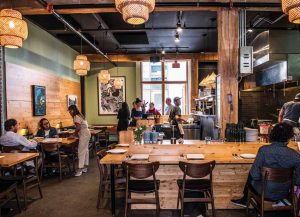
Wrisley’s inspiration for Shan came from the Japanese izakaya, which he describes as casual taverns where food and drink are equally important and where friends meet to have fun.
By April 2023, Shan was up and running. There were 44 seats, and Wrisley knew he needed to turn them two to three times a night to stay afloat.
In January 2024, the announcement came that Shan was a semifinalist for the James Beard Award. Three months later, it made the cut to the top 10 finalists.
“It was great for my team,” Wrisley says. “We work really, really hard to create a distinctive restaurant.” As evidence of that work, during the remodel, Wrisley took four of his staff to Bangkok — a city he calls one of the two or three best food cities in the world — to cook with renowned chefs in a different restaurant every day for a week. And Wrisley loves hosting chef friends from around the world for pop-up experiences at Shan.
The guiding principle, he says, is that Shan is a Montana restaurant with Asian flavors, rather than an Asian restaurant in Montana. “I’m cooking things I know from places I know,” he says, mentioning Chinese provinces where he lived and cooked, including Sichuan and Yunnan. In the mountains of Southwest China and Northern Thailand, Wrisley explains, the mainstays are often beef, lamb, pork, and water buffalo, and the spices are influenced by the landscape. “The best restaurants are an expression of place,” he says. And Shan, named for the Chinese character for mountains, is every inch a Montana establishment, from its meat-heavy menu and emphasis on local and regional ingredients to its friendly, unassuming, even laid-back culture.
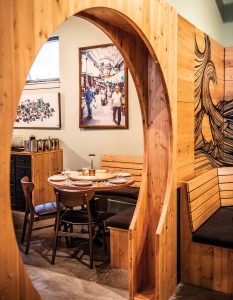
Wrisley expresses deep gratitude for the way the community has welcomed the restaurant with open arms, even making it necessary to double the seating. The restaurant becomes a more interesting, dynamic organism the more it changes, he says.
This is not a place to come for white tablecloths and overpriced steaks (in fact, the five-course set menu is $55 per person, and regular entrées range from $18 to $25), but it is as elegant as a scientific theory: ingenious, imaginative, and, in the right ways, utterly simple. Shan honors mountain culture with Asian flavors, Montana-grown ingredients, a deep respect for food traditions, and a whole lot of fun.
“It’s not a serious restaurant,” says Wrisley. Tell that to the James Beard folks, I want to say.
But he’s right. Eaters, makers, and servers alike all seem to be having too much fun to be serious. Shan is a place for people who love food, for people who seek adventure, and for those inclined to conflate the two.
Shan is open Tuesday through Saturday, from 4:30 to 9:30 p.m. Reservations can be made two weeks in advance; space at the counter and bar is for walk-ins.
Shan’s Thai Beef Jerky
BY JARRETT WRISLEY
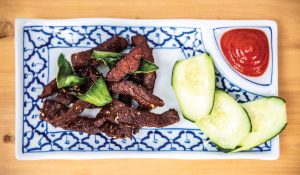
This recipe for nua det diao — which means, literally, meat dried in the sun for a day — was one of the first things I decided to cook in Bozeman. If there’s a dish where East meets West on our menu, this is it. This recipe works wonderfully with almost any protein; feel free to use it with elk, venison, pork, or lamb — all will be deli-cious. It’s also excessively simple in ways that most of our recipes aren’t, and all of these ingredients are within reach in Montana without much effort. In Thailand, the meat is dried in the sun, in baskets, or on racks, and if the sun is shining and it’s warm, I sug-gest you do the same. We can’t do that in the restaurant, of course, so we dry it in the oven. Once the exterior is dry and almost leath-ery to the touch, give it a quick fry, and it’s done. This is a snack often enjoyed with beer or a tall whiskey and soda with lots of ice.
Serves 8–10
5 tablespoons fish sauce
3 tablespoons light soy sauce 2 teaspoons white sugar
2 teaspoons white pepper powder (or finely ground black pepper)
1 teaspoon msg (optional)
1 tablespoon coriander seeds 1 tablespoon sesame seeds 2 pounds lean beef, cut into strips approximately
3 inches long, ¼ inch thick, and ½ inch wide
Mix the first 7 ingredients in a mixing bowl to create a marinade. Massage the mari-nade into the cut meat with your fingers.
Place meat on a wire rack, spacing pieces so they don’t touch each other. Dry for several hours in the sun or in an oven set at the lowest set-ting with the fan on (if possi-ble) for at least 1.5 hours. You don’t want to cook the meat, only dehydrate it.
Once the meat is dry on the outside, bring a shallow pot of oil to 350ºF and fry the meat in batches until it’s caramelized and brown on the outside.
Pat dry on paper towels and serve hot with sriracha sauce and slices of cucumber. Any leftover meat will keep for several days in the fridge.
Carter Walker is the author of several guidebooks, including Moon Montana & Wyoming (November 2022), Moon Montana (January 2023), Moon Wyoming (January 2023), and Moon Yellowstone to Glacier National Park Road Trip (May 2023). She lives in the Horseshoe Hills of Montana with her partner, two daughters, and a motley collection of well-traveled animals.
Photographer Lynn Donaldson shoots regularly for National Geographic, National Geographic Traveler, Travel & Leisure, Sunset, and The New York Times. The founder and editor of the Montana food and travel blog The Last Best Plates, Donaldson lives outside of Livingston, Montana with her husband and three children.




No Comments